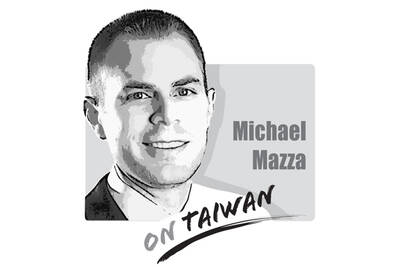More than 100 professionals, including the incumbent and former presidents of the Taiwanese Society of Psychiatry, have signed a petition calling for politicians to stop making suicide a campaign topic, Chinese-language media reported.
The petition came after separate news reports that a large number of bodies of people who apparently committed suicide had been found in Kaohsiung’s waterways, highlighting the issue, but also potentially triggering copycat attempts.
I log on to the popular gossip board on the Professional Technology Temple (PTT) online academic bulletin board system every day to skim through the headlines. About two to three months ago, I found that “floating corpses in Kaohsiung” was trending.
Searches for “floating corpses” on PTT return 85 results from before Chinese Nationalist Party (KMT) Kaohsiung mayoral candidate Ko Chih-en (柯志恩) posted about the issue on Sept. 16, with 33 of them being about Kaohsiung and 52 about other cities. If floating corpses are a prevalent issue in Taiwan, why is the spotlight on Kaohsiung?
Perhaps it is due to the media’s enthusiastic reporting, Internet users reposting Ko’s post and high click-through rates. The reporting on the issue might have led to more suicides in Kaohsiung, and consequently more suicide victims being found in the city’s waterways.
It shows that increased attention on suicide can exacerbate the problem. The more the public dwells on the subject, the more people might attempt suicide, therefore obliging the Kaohsiung City Government to increase its suicide prevention resources.
However, river banks are long, and there is only so much that a government can do. For decades, Kaohsiung’s suicide rate has ranked first or second among the six special municipalities. Kaohsiung is plagued with several issues, such as an aging population, economically disadvantaged rural areas and middle-age unemployment due to the relocation of pollution and labor-intensive industries. These could be factors in Kaohsiung’s high suicide rate.
However, these discussions are no match for the sensationalizing headlines about “floating corpses.”
The highest overall rate of suicide in Taiwan is among senior citizens. Of the six special municipalities, Taipei has the largest population of senior citizens, followed by Kaohsiung, but there is a large gap between the two cities’ suicide rates.
Senior citizens in the capital in 2015 had an annual income of NT$710,000 on average, which is not too different from the average income of NT$900,000 for those under 65, Taipei City Government data showed. With a vast Mass Rapid Transit system and a high density of hospitals, senior citizens can lead a satisfying and convenient life in Taipei.
Kaohsiung’s air pollution might also be a factor in the high suicide rate. Air pollution with fine particulate matter smaller than 2.5 micrometers can affect the human brain, and there is no academic consensus on its influence on the prevalence of suicide in highly polluted areas.
It might be impossible to stop the media and Internet users from hyping up the issue, but politicians should know better than to add fuel to the fire by discussing suicide methods.
The KMT could instead highlight the economic situation in Kaohsiung, the issue of young people from southern Taiwan relocating to the north as they search for better work opportunities, or the city government’s mental health budget.
It is up to Kaohsiung residents to decide if they have been satisfied with the policies implemented by Kaohsiung Mayor Chen Chi-mai (陳其邁) over the past two years. Nonetheless, people should, above all, lay off the phrase “floating corpses.”
Chen Fong-wei is a psychiatrist.
Translated by Rita Wang
The image was oddly quiet. No speeches, no flags, no dramatic announcements — just a Chinese cargo ship cutting through arctic ice and arriving in Britain in October. The Istanbul Bridge completed a journey that once existed only in theory, shaving weeks off traditional shipping routes. On paper, it was a story about efficiency. In strategic terms, it was about timing. Much like politics, arriving early matters. Especially when the route, the rules and the traffic are still undefined. For years, global politics has trained us to watch the loud moments: warships in the Taiwan Strait, sanctions announced at news conferences, leaders trading
The saga of Sarah Dzafce, the disgraced former Miss Finland, is far more significant than a mere beauty pageant controversy. It serves as a potent and painful contemporary lesson in global cultural ethics and the absolute necessity of racial respect. Her public career was instantly pulverized not by a lapse in judgement, but by a deliberate act of racial hostility, the flames of which swiftly encircled the globe. The offensive action was simple, yet profoundly provocative: a 15-second video in which Dzafce performed the infamous “slanted eyes” gesture — a crude, historically loaded caricature of East Asian features used in Western

Is a new foreign partner for Taiwan emerging in the Middle East? Last week, Taiwanese media reported that Deputy Minister of Foreign Affairs Francois Wu (吳志中) secretly visited Israel, a country with whom Taiwan has long shared unofficial relations but which has approached those relations cautiously. In the wake of China’s implicit but clear support for Hamas and Iran in the wake of the October 2023 assault on Israel, Jerusalem’s calculus may be changing. Both small countries facing literal existential threats, Israel and Taiwan have much to gain from closer ties. In his recent op-ed for the Washington Post, President William
A stabbing attack inside and near two busy Taipei MRT stations on Friday evening shocked the nation and made headlines in many foreign and local news media, as such indiscriminate attacks are rare in Taiwan. Four people died, including the 27-year-old suspect, and 11 people sustained injuries. At Taipei Main Station, the suspect threw smoke grenades near two exits and fatally stabbed one person who tried to stop him. He later made his way to Eslite Spectrum Nanxi department store near Zhongshan MRT Station, where he threw more smoke grenades and fatally stabbed a person on a scooter by the roadside.